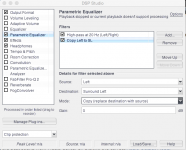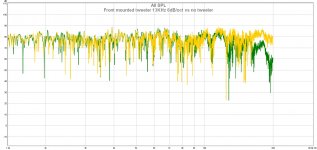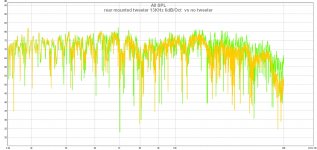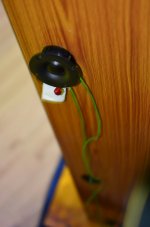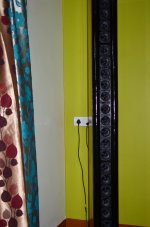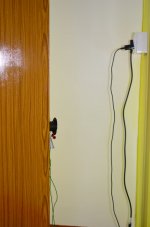Thanks for reporting back with your experiences, rockk19...
It's good to read your report on damping the room. That sucks out a lot of wild reflections that scatter about the room. But I have to say, that sense of envelopment the reflections added also had benefits. That's why I introduced fake controlled reflections after first removing as much as I could. With the first 20 ms as clean as possible and the tail of the back reflections you get more sense of a 3D sound than without it.
I even played a few movies while feeding them with a stereo mix down and it is very pleasing. I haven't bothered yet to feed a 4.0 sound trough it for movies. My son saw his favourite movie with the surround speakers engaged and commented: "it's like a whole new world!" So I think it works 😀.
I haven't been able yet to keep my hands off as it is way too much fun to play with the new addition. I've rerouted the cables so the second amp is now part of my permanent setup. The test results were more than good enough for that.
But in general, I've played lots of music. All kinds and not just the usual test tracks. Had a lot of fun just listening for a change.
Let us know how the (ambient?) tweeters work out! That is still something I'm very curious about.
It's good to read your report on damping the room. That sucks out a lot of wild reflections that scatter about the room. But I have to say, that sense of envelopment the reflections added also had benefits. That's why I introduced fake controlled reflections after first removing as much as I could. With the first 20 ms as clean as possible and the tail of the back reflections you get more sense of a 3D sound than without it.
I even played a few movies while feeding them with a stereo mix down and it is very pleasing. I haven't bothered yet to feed a 4.0 sound trough it for movies. My son saw his favourite movie with the surround speakers engaged and commented: "it's like a whole new world!" So I think it works 😀.
I haven't been able yet to keep my hands off as it is way too much fun to play with the new addition. I've rerouted the cables so the second amp is now part of my permanent setup. The test results were more than good enough for that.
But in general, I've played lots of music. All kinds and not just the usual test tracks. Had a lot of fun just listening for a change.
Let us know how the (ambient?) tweeters work out! That is still something I'm very curious about.
But in general, I've played lots of music. All kinds and not just the usual test tracks. Had a lot of fun just listening for a change.
That's nice. Taking a break from analysing and just enjoying the music!
I, too, I'm interested in the extra tweeter help.
That's nice. Taking a break from analysing and just enjoying the music!
Well, it didn't take me long to be back at analysing 🙄. Something was off, at least different from what I remembered it could be. But the biggest difference I had introduces was the move from WASAPI to Asio. I need the Asio driver to be able to have both my ambient speakers and mains trough S/PDIF playing together. After a random change in buffer size and upsampling to 88200 from 44100 things sounded better. But what just happened?
So I figured I'd do a BYRTT and measure 😉.
Here's the loopback of the Asio output at 44100 (after the buffer change by the way):

Even more important, I couldn't get stable measurements with all of my processing in line. Lots of hiccup during a loopback measurement (*). So I tried some different buffer settings within JRiver as well as my Asio driver. Measurements were getting more stable with all EQ and FIR DSP active, except JRiver's graphic EQ gave me a wiggle in the GD plot around 200 Hz.
Mid/Side processing (LoCo) had some minor problems breaking up the high frequency correction.
With a bit of work I got to this loopback of REW -> Asio 88200 -> S/PDIF -> Musical Fidelity M1 DAC -> Mic in on Asus ST -> REW.

It now looks this way at both 44100 and 88200 with the Asio driver and exactly like the WASAPI driver I was using before adding the ambient chain.
So far I'm pleased. Didn't get to hear it much during the weekend, except for a movie which sounded just fabulous.
(*) = lots of wiggles at random points during measurements and a break off in high frequencies with all processing active. The 88200 sample rate had the least problems and extended higher (boost of higher frequencies). As I didn't redo the mains measurements after switching to Asio this was probably caused by minor differences between both driver options, WASAPI and Asio. The random wiggles didn't happen anymore after the buffer changes except when using mid-side processing with the S-curve. I'll be looking for another solution there. Graphic EQ is deactivated after adding the changes to my DRC-FIR target.
One other advantage is that I now know my max boost figure at low frequencies, I boost a maximum of 16 MB at 20 Hz. Previously I had to guess what it was exactly, now it was easy to see compared to a straight loop-back.
There is something to be said about knowing what you're listening to. 😉
Thanks for the inspiration BYRTT! 😀
Last edited:
Asio drivers really differ from brand to brand, and is barely acceptable when using ASIO4ALL.
They are the culprit for many poorly written audio drivers.
Glad you figured it out!
They are the culprit for many poorly written audio drivers.
Glad you figured it out!
Very true, this exercise was with Asus Xonar Essence ST's original Asio drivers. Long before finishing my speakers I've tried everything, including ASIO4ALL. While it does make some things possible that you can't get elsewhere I didn't have much luck with that one. I was very content with the WASAPI drivers for the Asus S/PDIF out. But now I am forced to use Asio to be able to use the multiple channels plus the S/PDIF out.
I'm using the Asio driver at an undocumented sample rate of 88200/24 bit.
Maximum input sample rate of my DAC is 96000/24 bit. That's what I use for movies.
With the WASAPI drivers up sampling didn't improve my signal, with Asio it does, but only by a very small margin. But I'll take any improvement I can get.
I'm using the Asio driver at an undocumented sample rate of 88200/24 bit.
Maximum input sample rate of my DAC is 96000/24 bit. That's what I use for movies.
With the WASAPI drivers up sampling didn't improve my signal, with Asio it does, but only by a very small margin. But I'll take any improvement I can get.
I am using that function. But WASAPI either runs S/PDIF or the Asus ST channels, but not both. Asio does.
My DAC is slaved to the Asus trough S/PDIF. It is much cleaner in output than only using the Asus. 😉
My DAC is slaved to the Asus trough S/PDIF. It is much cleaner in output than only using the Asus. 😉
A few days further I am glad I used the loop back from REW trough JRiver and DAC back into REW to check all of my processing. I cleaned up the signal processing and removed a highly ringing vst (in my case, the vst host I was using, can't blame of fault it, but it caused heavy rippling of my signal when working with delayed signals needed for a phase linear EQ). A different EQ vst with mid/side capabilities has replaced it.(*) The clean up of the signal did give me a more clear sense of depth. Now I know why I sometimes had it (the depth part), but somehow lost it at times. The speakers have performed stable ever since. The Asio driver has been proven stable with the altered buffer settings.
Lesson learned: also check your signal when using digital tools. It also showed I use a maximum boost of 16 dB in the low frequencies. I figured as much but it's good to have the confirmation.
(*) actually 2 at the moment one for mid, one for side, looking for a more definitive solution. These are not linear phase. As it only consists of gentle broad EQ I don't think it is a big problem. Didn't look that way in loop back but would be fun to test both sometime.
Lesson learned: also check your signal when using digital tools. It also showed I use a maximum boost of 16 dB in the low frequencies. I figured as much but it's good to have the confirmation.
(*) actually 2 at the moment one for mid, one for side, looking for a more definitive solution. These are not linear phase. As it only consists of gentle broad EQ I don't think it is a big problem. Didn't look that way in loop back but would be fun to test both sometime.
Last edited:
Did you try Voxengo Soniformer? They have a demo.
It has 32-band EQ, stereo tools, mid/side processing, and is even multichannels (for your ambient speakers).
It has 32-band EQ, stereo tools, mid/side processing, and is even multichannels (for your ambient speakers).
Extra Tweeter
I have been playing with a 1" silk dome tweeter added to my arrays for a while now. All I can say is: its worth trying. As for myself, I won't be looking back.
I compared both front and rear mounting of the tweeters using 1st, 2nd, 3rd and 4th order active crossovers. Front mounting does not work well with the stealthy signature of the arrays. Something was off. Rear mounting with 3rd and 4th order crossover at 13KHz sounded artificial. 9KHz filter was a little better. Worst was a 60 dB/Oct filter at 13KHz.
Unexpectedly, what I loved most was a 2nd /1st order filter at 13KHz, rear mounted tweeter. The addition of the tweeter is quite distinct. I was indeed missing quite the sparkle! Its like my treble got upgraded to high definition.
I cannot continue using an active crossover for the tweeters, so I am using a 1st order 13KHz simple capacitor crossover filter for now. Working great so far! I plan to upgrade to 2 rear mounted tweeters in series per channel with 12dB/oct passive crossover at 13KHz.
I was under the impression that using a tweeter front mounted with a 1st or 2nd order non-steep filter would put serious holes in the arrays frequency response. My test results have proved me somewhat wrong. There isn't much difference between the array's frequency response without tweeter and with tweeter on a 1st order crossover at 13KHz, other than the added response around and above the crossover point, starting from 11KHz in this case. Please see attached graphs. Anyways, front mounting did not work for me.
I also tried front and rear mounting with 7.5ms delay (its all I can afford with my miniDSP). There was no advantage whatsoever. It just messed up my early decay time. Maybe around 20ms delay is what I needed.
I have been playing with a 1" silk dome tweeter added to my arrays for a while now. All I can say is: its worth trying. As for myself, I won't be looking back.
I compared both front and rear mounting of the tweeters using 1st, 2nd, 3rd and 4th order active crossovers. Front mounting does not work well with the stealthy signature of the arrays. Something was off. Rear mounting with 3rd and 4th order crossover at 13KHz sounded artificial. 9KHz filter was a little better. Worst was a 60 dB/Oct filter at 13KHz.
Unexpectedly, what I loved most was a 2nd /1st order filter at 13KHz, rear mounted tweeter. The addition of the tweeter is quite distinct. I was indeed missing quite the sparkle! Its like my treble got upgraded to high definition.
I cannot continue using an active crossover for the tweeters, so I am using a 1st order 13KHz simple capacitor crossover filter for now. Working great so far! I plan to upgrade to 2 rear mounted tweeters in series per channel with 12dB/oct passive crossover at 13KHz.
I was under the impression that using a tweeter front mounted with a 1st or 2nd order non-steep filter would put serious holes in the arrays frequency response. My test results have proved me somewhat wrong. There isn't much difference between the array's frequency response without tweeter and with tweeter on a 1st order crossover at 13KHz, other than the added response around and above the crossover point, starting from 11KHz in this case. Please see attached graphs. Anyways, front mounting did not work for me.
I also tried front and rear mounting with 7.5ms delay (its all I can afford with my miniDSP). There was no advantage whatsoever. It just messed up my early decay time. Maybe around 20ms delay is what I needed.
Attachments
Did you try Voxengo Soniformer? They have a demo.
It has 32-band EQ, stereo tools, mid/side processing, and is even multichannels (for your ambient speakers).
It needs to be PEQ for me. Otherwise I love the Voxengo stuff I tried so far.
I might test it in place of the graphic EQ of JRiver.
I have been playing with a 1" silk dome tweeter added to my arrays for a while now. All I can say is: its worth trying. As for myself, I won't be looking back.
I compared both front and rear mounting of the tweeters using 1st, 2nd, 3rd and 4th order active crossovers. Front mounting does not work well with the stealthy signature of the arrays. Something was off. Rear mounting with 3rd and 4th order crossover at 13KHz sounded artificial. 9KHz filter was a little better. Worst was a 60 dB/Oct filter at 13KHz.
Unexpectedly, what I loved most was a 2nd /1st order filter at 13KHz, rear mounted tweeter. The addition of the tweeter is quite distinct. I was indeed missing quite the sparkle! Its like my treble got upgraded to high definition.
I cannot continue using an active crossover for the tweeters, so I am using a 1st order 13KHz simple capacitor crossover filter for now. Working great so far! I plan to upgrade to 2 rear mounted tweeters in series per channel with 12dB/oct passive crossover at 13KHz.
I was under the impression that using a tweeter front mounted with a 1st or 2nd order non-steep filter would put serious holes in the arrays frequency response. My test results have proved me somewhat wrong. There isn't much difference between the array's frequency response without tweeter and with tweeter on a 1st order crossover at 13KHz, other than the added response around and above the crossover point, starting from 11KHz in this case. Please see attached graphs. Anyways, front mounting did not work for me.
I also tried front and rear mounting with 7.5ms delay (its all I can afford with my miniDSP). There was no advantage whatsoever. It just messed up my early decay time. Maybe around 20ms delay is what I needed.
Interesting results. Makes me want to try it out! (lol) I'd love to try a AMT style tweeter as ambient. Do you have a picture of the back firing tweeter?
How close is it to the wall behind the speaker? I was wondering if I should aim it up or to the front wall (the one behind the speaker).
How close is it to the wall behind the speaker? I was wondering if I should aim it up or to the front wall (the one behind the speaker).
My first idea was to place a silk dome (or even a small horn style) tweeter aimed at the ceiling, bouncing back to my listening position.. But a back firing one could be interesting as well.
I have been playing with a 1" silk dome tweeter added to my arrays for a while now. All I can say is: its worth trying. As for myself, I won't be looking back.
I compared both front and rear mounting of the tweeters using 1st, 2nd, 3rd and 4th order active crossovers. Front mounting does not work well with the stealthy signature of the arrays. Something was off. Rear mounting with 3rd and 4th order crossover at 13KHz sounded artificial. 9KHz filter was a little better. Worst was a 60 dB/Oct filter at 13KHz.
Unexpectedly, what I loved most was a 2nd /1st order filter at 13KHz, rear mounted tweeter. The addition of the tweeter is quite distinct. I was indeed missing quite the sparkle! Its like my treble got upgraded to high definition.
I cannot continue using an active crossover for the tweeters, so I am using a 1st order 13KHz simple capacitor crossover filter for now. Working great so far! I plan to upgrade to 2 rear mounted tweeters in series per channel with 12dB/oct passive crossover at 13KHz.
I was under the impression that using a tweeter front mounted with a 1st or 2nd order non-steep filter would put serious holes in the arrays frequency response. My test results have proved me somewhat wrong. There isn't much difference between the array's frequency response without tweeter and with tweeter on a 1st order crossover at 13KHz, other than the added response around and above the crossover point, starting from 11KHz in this case. Please see attached graphs. Anyways, front mounting did not work for me.
I also tried front and rear mounting with 7.5ms delay (its all I can afford with my miniDSP). There was no advantage whatsoever. It just messed up my early decay time. Maybe around 20ms delay is what I needed.
Nice result Rockk19, thanks for sharing. What tweeter do you use, how many, and what size cap for the passive HPF XO?
Based on the measurements of the two black cone TG9FD (TPY03W06's) you gave me, I have no doubt your arrays sound amazing. Those are fantastic drivers! Price has no relationship to good sound as these were $6 drivers!
Rockk19, one more thing to ask: what did it do for the stage or imaging? Can you describe that? Over the past week where I changed/cleaned up my signal I did notice how important the high frequency response is for our perception.
wesayso agree how important HF stuff is for perception, after these clean ups suggest try passive RC and RLC network again, it could be there come a day they suddenly improve system.
wesayso agree how important HF stuff is for perception, after these clean ups suggest try passive RC and RLC network again, it could be there come a day they suddenly improve system.
Part of it never left, the part that was measurably better 🙂.
I still have the RLC in place.
My arrays are placed at 50cm distance from the side wall and at 45cm distance from the front wall. The side wall distance is less than optimal according to me, wish I could move the walls 😱
I have very conveniently stuck the tweeter in one of the rear ports 😀
Thats around 1 metre above the floor. My speakers are 20 degrees toed in. So, the tweeter is hitting the front wall at 20 degrees too.
I am using a Peerless India 26mm silk dome tweeter. Right now, I am using 1.66 uF cap ( 1 + 0.33 + 0.33) 1st order HPF. Thats around 16KHz for the 6Ohms tweeter. Its a decent quality $20 tweeter.
I was lucky with the tweeter's sensitivity. I am wiring it parallel to the main array at the binding post. I am not having to make any level adjustments between the tweeters and the arrays. The tweeters are 90dB sensitive at 10KHz with a broad 4 dB peak from 12 to 16 KHz.
About stage and/or imaging, I am not so sure how to describe. I guess a greater side and front wall distance would have had more effect on the staging and spaciousness. What I have perceived so far is that the rear tweeters are helping the arrays disappear even more 😱 The sparkles are flying or floating all over! The air is in the air! I can definitely feel an increased 3D effect in the audio space. With the arrays, stage and imaging are more engaging. It pulls you in more than without the tweeters. Hope I am making some sense.
Ceiling aiming tweeters were on my list to be tried out. Can't remember why I didn't bother. i'll try that later.
Its very hard to do A/B comparison within short listening period. For with and without tweeters comparison, I did extensive listening tests with a tweeter only on the left array. It was fun. Difference was really really obvious between left and right. It was a no brainier after that.
AMT or ribbon should be awesome. Wonder how horns would work out, given their tighter dispersion.
I have very conveniently stuck the tweeter in one of the rear ports 😀
Thats around 1 metre above the floor. My speakers are 20 degrees toed in. So, the tweeter is hitting the front wall at 20 degrees too.
I am using a Peerless India 26mm silk dome tweeter. Right now, I am using 1.66 uF cap ( 1 + 0.33 + 0.33) 1st order HPF. Thats around 16KHz for the 6Ohms tweeter. Its a decent quality $20 tweeter.
I was lucky with the tweeter's sensitivity. I am wiring it parallel to the main array at the binding post. I am not having to make any level adjustments between the tweeters and the arrays. The tweeters are 90dB sensitive at 10KHz with a broad 4 dB peak from 12 to 16 KHz.
About stage and/or imaging, I am not so sure how to describe. I guess a greater side and front wall distance would have had more effect on the staging and spaciousness. What I have perceived so far is that the rear tweeters are helping the arrays disappear even more 😱 The sparkles are flying or floating all over! The air is in the air! I can definitely feel an increased 3D effect in the audio space. With the arrays, stage and imaging are more engaging. It pulls you in more than without the tweeters. Hope I am making some sense.
Ceiling aiming tweeters were on my list to be tried out. Can't remember why I didn't bother. i'll try that later.
Its very hard to do A/B comparison within short listening period. For with and without tweeters comparison, I did extensive listening tests with a tweeter only on the left array. It was fun. Difference was really really obvious between left and right. It was a no brainier after that.
AMT or ribbon should be awesome. Wonder how horns would work out, given their tighter dispersion.
Attachments
Thanks for the pictures...
I know what you talk about, the notes seem to float on songs 🙂. Try "Tsunami" from DVBBS and Borgeous. Awful song but when the midrange kicks in....
No big damping panels on the side walls yet? I bet that would help opening up the stage some more...
I know what you talk about, the notes seem to float on songs 🙂. Try "Tsunami" from DVBBS and Borgeous. Awful song but when the midrange kicks in....
No big damping panels on the side walls yet? I bet that would help opening up the stage some more...
Thanks for the 'tsunami'. Thats some track!
I love what the tweeters are doing to 'Hotel California' !
I have a large window to my left. So I am using 9 feet high heavy drapes for damping.
These are my bedroom speakers. So, a 1.5 ft deep and 5ft wide open clothes rack on the right. A clothe rack is very good for damping. Highly customizable 😉
I got a 4inches deep 3ft X 6ft wedge acoustic foam damping for the rear wall.
I love what the tweeters are doing to 'Hotel California' !
I have a large window to my left. So I am using 9 feet high heavy drapes for damping.
These are my bedroom speakers. So, a 1.5 ft deep and 5ft wide open clothes rack on the right. A clothe rack is very good for damping. Highly customizable 😉
I got a 4inches deep 3ft X 6ft wedge acoustic foam damping for the rear wall.
I thought I was finished...
Well as I said, I'm pretty happy with how my setup has been performing lately. Lot's of shivers, goose bumps and dare I say it even some tears.
But I never though it would be so difficult to get all my favourite vinyl albums in a digital version. From some bands I like very much I've only listened to the vinyl for years on end. Sometimes buying the CD but never really taking notice. For instance Led Zeppelin. I have all of it on vinyl, even some rare stuff and singles.
I had some great live stuff on CD and bought a complete box with all studio recordings a long while back. But somehow it didn't do it for me, not like the old vinyl's. I had no intend to include a record player again, having a completely digital setup this time. But the CD's I had felt short. I even tried some Japanese import SHCD's as they did get a lot of praise.
For Led Zeppelin it wasn't until the High Res Remasters came out that I felt I was listening to my old albums again. But luckily that solved the problem.
Still a lot of bands left that I have the same problem with. Every once in a while I'd buy an anniversary version when I bumped into it. Never even playing it up till now. Bad choice! A lot of the so called Remasters have been nothing but head aches. And I don't blame the CD as a medium. It is incredible how different the mastering can be on some of these bands. As I go along slowly but surely I can find pressings with the sound I remember so fondly. They do exist! But does it really have to be this hard? Some of those CD's are really not worth the packaging. No wonder the vinyl records have made such a big come back.
But really, even red-book CD can sound fine! I bet a lot of it comes down to at which volume the mastering was done. I like to play it at say 85 dB average and have it sound good. Lots and lots of CD's actually sound pretty good that way. Sadly not all of them.
Van Halen for instance doesn't even seem to have bass at that level of SPL. With one exception being the DCC version of their self titled debut album mastered by Steve Hoffman. That version is at least 3 dB hotter in bass (from ~200 Hz down) than even the new remasters. And I do not refer to the recent 2015 remasters brought out on CD though, they are a complete disaster as well, but strangely the High Res 192/24 version is actually pretty good, except still falling short on bass. But at least they are not compressed to s##t as their 2015 CD counterpart. Sadly I have found no other CD's in the Van Halen catalogue mastered by Mr. Hoffman. I know I liked his versions of The Doors on CD as well.
I wish it was easier to get back the sounds of my youth. Maybe I do need to fetch that record player from the attic. But the vinyl I still have has been played to death. I still have over 400 of them upstairs.
I have downloaded some of the vinyl rips to see if that could fill the hole. Neh, hit and miss just like buying a regular CD. And I certainly don't look forward ripping all of those albums I have.
Any of you guys recognise this? I seem to have some luck with some of the Japanese pressings of the 80's bands I liked.
A lot of older stuff actually is pretty decent on CD, though sometimes that too takes some work here and there. The difference between the good and the bad is huge! Some Remasters I had bought I didn't even recognise the songs!
Edit: don't get me wrong here 🙂, most CD's sound pretty good or even great. It's just that some of the rock albums I used to play on record never really got a CD pressing that could compete. I made the switch in the early 90's somewhere, but still buying vinyl as well in that period. It's mostly the stuff I have only truly heard on vinyl that makes it hard. Sure, the loudness wars have played a role here as well. Remasters that were compressed to bits. But sadly that's what I had saved up as backup copies to albums I used to own.
To setup and test my system I used completely different and a wide variety of music. The stuff I discovered trough forums like this and others and CD's that I've listened to for a long time (never having owned a vinyl edition of those)...
I guess we really do need some strict guidelines, at least an average SPL level which the music should have at play back.
🙄 End of Rant 🙄
Well as I said, I'm pretty happy with how my setup has been performing lately. Lot's of shivers, goose bumps and dare I say it even some tears.
But I never though it would be so difficult to get all my favourite vinyl albums in a digital version. From some bands I like very much I've only listened to the vinyl for years on end. Sometimes buying the CD but never really taking notice. For instance Led Zeppelin. I have all of it on vinyl, even some rare stuff and singles.
I had some great live stuff on CD and bought a complete box with all studio recordings a long while back. But somehow it didn't do it for me, not like the old vinyl's. I had no intend to include a record player again, having a completely digital setup this time. But the CD's I had felt short. I even tried some Japanese import SHCD's as they did get a lot of praise.
For Led Zeppelin it wasn't until the High Res Remasters came out that I felt I was listening to my old albums again. But luckily that solved the problem.
Still a lot of bands left that I have the same problem with. Every once in a while I'd buy an anniversary version when I bumped into it. Never even playing it up till now. Bad choice! A lot of the so called Remasters have been nothing but head aches. And I don't blame the CD as a medium. It is incredible how different the mastering can be on some of these bands. As I go along slowly but surely I can find pressings with the sound I remember so fondly. They do exist! But does it really have to be this hard? Some of those CD's are really not worth the packaging. No wonder the vinyl records have made such a big come back.
But really, even red-book CD can sound fine! I bet a lot of it comes down to at which volume the mastering was done. I like to play it at say 85 dB average and have it sound good. Lots and lots of CD's actually sound pretty good that way. Sadly not all of them.
Van Halen for instance doesn't even seem to have bass at that level of SPL. With one exception being the DCC version of their self titled debut album mastered by Steve Hoffman. That version is at least 3 dB hotter in bass (from ~200 Hz down) than even the new remasters. And I do not refer to the recent 2015 remasters brought out on CD though, they are a complete disaster as well, but strangely the High Res 192/24 version is actually pretty good, except still falling short on bass. But at least they are not compressed to s##t as their 2015 CD counterpart. Sadly I have found no other CD's in the Van Halen catalogue mastered by Mr. Hoffman. I know I liked his versions of The Doors on CD as well.
I wish it was easier to get back the sounds of my youth. Maybe I do need to fetch that record player from the attic. But the vinyl I still have has been played to death. I still have over 400 of them upstairs.
I have downloaded some of the vinyl rips to see if that could fill the hole. Neh, hit and miss just like buying a regular CD. And I certainly don't look forward ripping all of those albums I have.
Any of you guys recognise this? I seem to have some luck with some of the Japanese pressings of the 80's bands I liked.
A lot of older stuff actually is pretty decent on CD, though sometimes that too takes some work here and there. The difference between the good and the bad is huge! Some Remasters I had bought I didn't even recognise the songs!
Edit: don't get me wrong here 🙂, most CD's sound pretty good or even great. It's just that some of the rock albums I used to play on record never really got a CD pressing that could compete. I made the switch in the early 90's somewhere, but still buying vinyl as well in that period. It's mostly the stuff I have only truly heard on vinyl that makes it hard. Sure, the loudness wars have played a role here as well. Remasters that were compressed to bits. But sadly that's what I had saved up as backup copies to albums I used to own.
To setup and test my system I used completely different and a wide variety of music. The stuff I discovered trough forums like this and others and CD's that I've listened to for a long time (never having owned a vinyl edition of those)...
I guess we really do need some strict guidelines, at least an average SPL level which the music should have at play back.
🙄 End of Rant 🙄
Last edited:
- Home
- Loudspeakers
- Full Range
- The making of: The Two Towers (a 25 driver Full Range line array)
